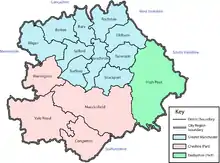Manchester City Region
The Greater Manchester City Region,[1][2][3] commonly just the Manchester City Region and sometimes the Greater Manchester Statutory City Region,[4][5] is a combined authority region in England, consisting of Greater Manchester and five boroughs, roughly the historic county of Lancashire's eastern parts. It is under the strategic governance of the Greater Manchester Combined Authority, officially designated on 1 April 2011 and has a population of 3,363,555 according to figures from the office for national statistics (2011) [6]
Manchester City Region
Greater Manchester Statutory City Region | |
|---|---|
| Sovereign state | |
| Constituent country | |
| Region | North West England |
| Established | 1 April 2011 (as a combined authority) |
| Administrative HQ | Manchester |
| Districts | |
| Government | |
| • Type | Combined authority Local enterprise partnership |
| • Body | Greater Manchester Combined Authority Greater Manchester Local Enterprise Partnership |
| • Leadership | Metro mayor and indirectly-elected membership (Combined authority) Chairman and board (Local enterprise partnership) |
| • Leader | Andy Burnham (Combined authority) Mike Blackburn (Local enterprise partnership) |
| Area | |
| • Total | 493 sq mi (1,276 km2) |
| Population (mid-2019 est.) | |
| • Total | 3,363,555 |
| Time zone | UTC0 (Greenwich Mean Time) |
| • Summer (DST) | UTC+1 (British Summer Time) |
| Website | www.greatermanchester-ca.gov.uk (Combined authority) www.gmlep.com (Local enterprise partnership) |
The Manchester City Region initially appeared as one of eight city regions defined in the 2004 strategic document Moving Forward: The Northern Way,[7] as a collaboration between three regional development agencies. It encompassed the ten districts of Greater Manchester and five neighbouring local government districts,[1] and was suggested as an effective administrative metropolitan area that could share resources and stimulate economic growth in northern England. In the late 2000s, the Association of Greater Manchester Authorities (AGMA) began actively lobbying for a statutory local government framework for the Manchester City Region in exchange for greater autonomy from the UK central government.[2] They used the term 'Manchester City Region' as a synonym for 'Greater Manchester' (a metropolitan county), and excluded neighbouring districts.[8] Following the 2009 United Kingdom Budget, the city region—abridged to the ten districts of Greater Manchester—was announced as a pilot region which could establish a formal corporate strategic government with powers comparable with the Greater London Authority. AGMA agreed to the creation of the Greater Manchester Combined Authority in March 2010; on 1 April 2011 the combined authority was established.
History

Between the publication of the Moving Forward: The Northern Way in 2004, through to the 2009 structural changes to local government in England, the Manchester City Region encompassed fifteen local government districts: the cities of Manchester and Salford plus the metropolitan boroughs of Stockport, Tameside, Trafford, Bolton, Bury, Oldham, Rochdale and Wigan , together with the boroughs of High Peak, Warrington and the former boroughs of Congleton, Macclesfield and Vale Royal.[9]
Since the 2009 structural changes to local government in England, the Association of Greater Manchester Authorities has used the term 'Manchester City Region' as a synonym for Greater Manchester, describing it as "a highly coherent single economic region", with reference to the "ten districts of the city region".[8] AGMA have published that in their literature "‘Manchester’ and ‘city region’ are used to refer to Greater Manchester, which is the ten local authority Districts of Bolton, Bury, Oldham, Manchester, Rochdale, Stockport, Salford, Tameside, Trafford and Wigan".[10]
The Greater Manchester Statutory City Region was announced in the 2009 United Kingdom Budget as one of two such pilot city regions in the UK (the other being the Leeds City Region).[11] Once created, it saw the ten metropolitan borough councils of Greater Manchester banding together as a combined authority to pool resources over skills, housing, transport and economic development, in exchange for greater powers from the UK central government.[12]
See also
References
- North West Regional Assembly (2004). "Brief for the Preparation of a Sub-Regional Strategy for Greater Manchester City Region" (PDF). 4nw.org.uk. Archived from the original (PDF) on 2011-10-04. Retrieved 2010-03-11.
- "City Region pilots". communities.gov.uk. 2009. Archived from the original on 2009-02-19. Retrieved 2010-03-11.
- http://www.lgcplus.com/policy-and-politics/economic-development/greater-manchester-city-region-attacked/5001943.article
- Oldham Council (2010-02-16). "Greater Manchester Statutory City Region - Governance Arrangements". oldham.gov.uk. Retrieved 2010-03-12.
- "The Manchester Statutory City Region" (PDF). agma.gov.uk. 2009-12-28. Retrieved 2010-03-12.
- "Office for National Statistics UK Populations". 2011. ONS. Retrieved 7 April 2014.
- Moving Forward:The Northern Way Archived 2008-12-06 at the Wayback Machine
- Association of Greater Manchester Authorities (August 2009). "Prosperity for all: The Greater Manchester Strategy" (PDF). agma.gov.uk. Retrieved 2010-03-11.
- "A Framework for City Regions Working Paper" (PDF). Newcastle University UK. Office of the Deputy Prime Minister. Archived from the original (PDF) on 24 January 2016. Retrieved 16 April 2015.
- Association of Greater Manchester Authorities (2009-07-21). "Manchester: Statutory City Region Pilot" (PDF). agma.gov.uk. Retrieved 2010-03-12.
- http://downloads.bbc.co.uk/news/nol/shared/bsp/hi/pdfs/22_04_09bud09_completereport_2591.pdf
- Hayman, Allister (2010-03-01). "Stockport and Trafford councils abstain from city-region vote". regen.net. Retrieved 2010-03-11.
